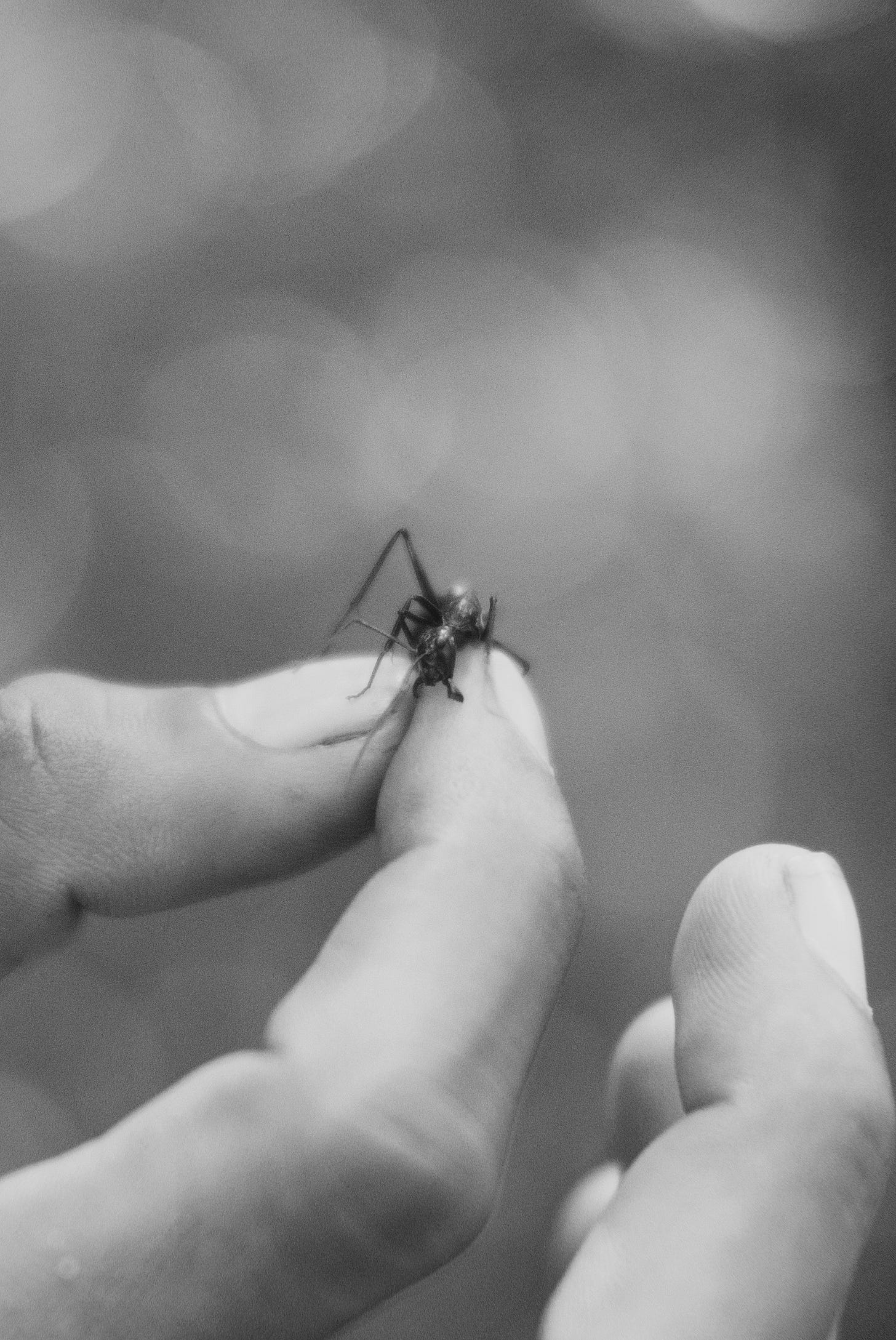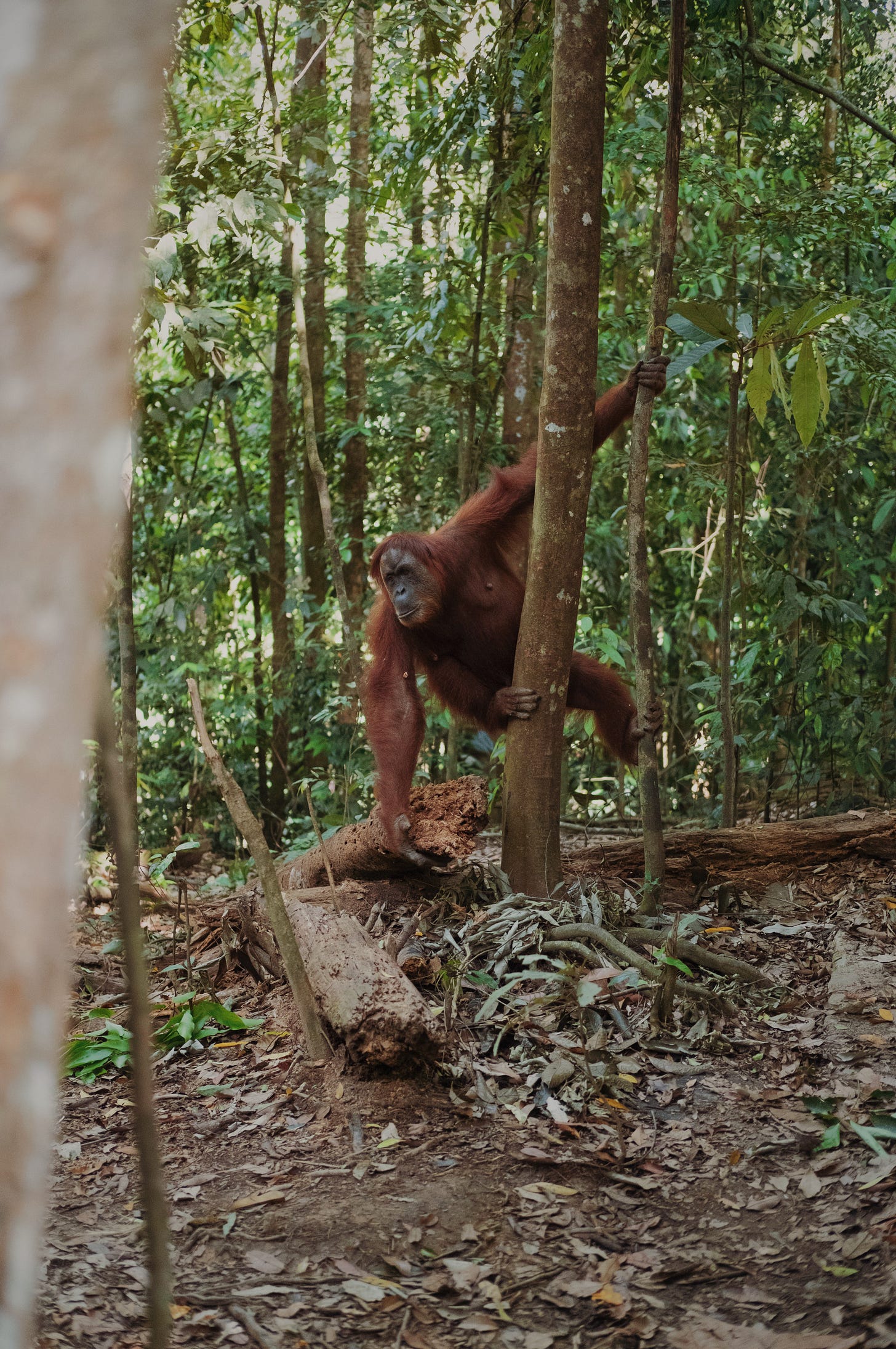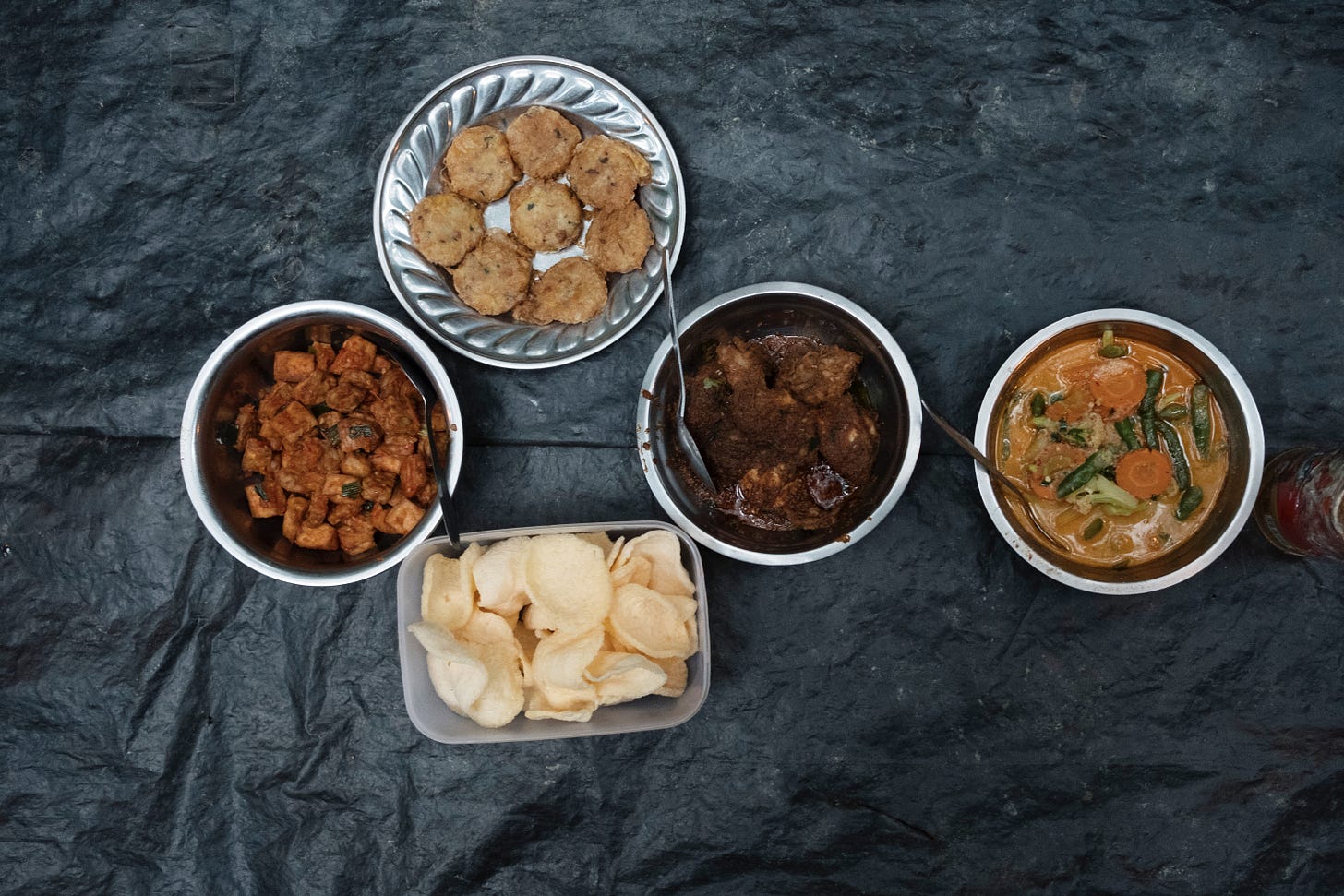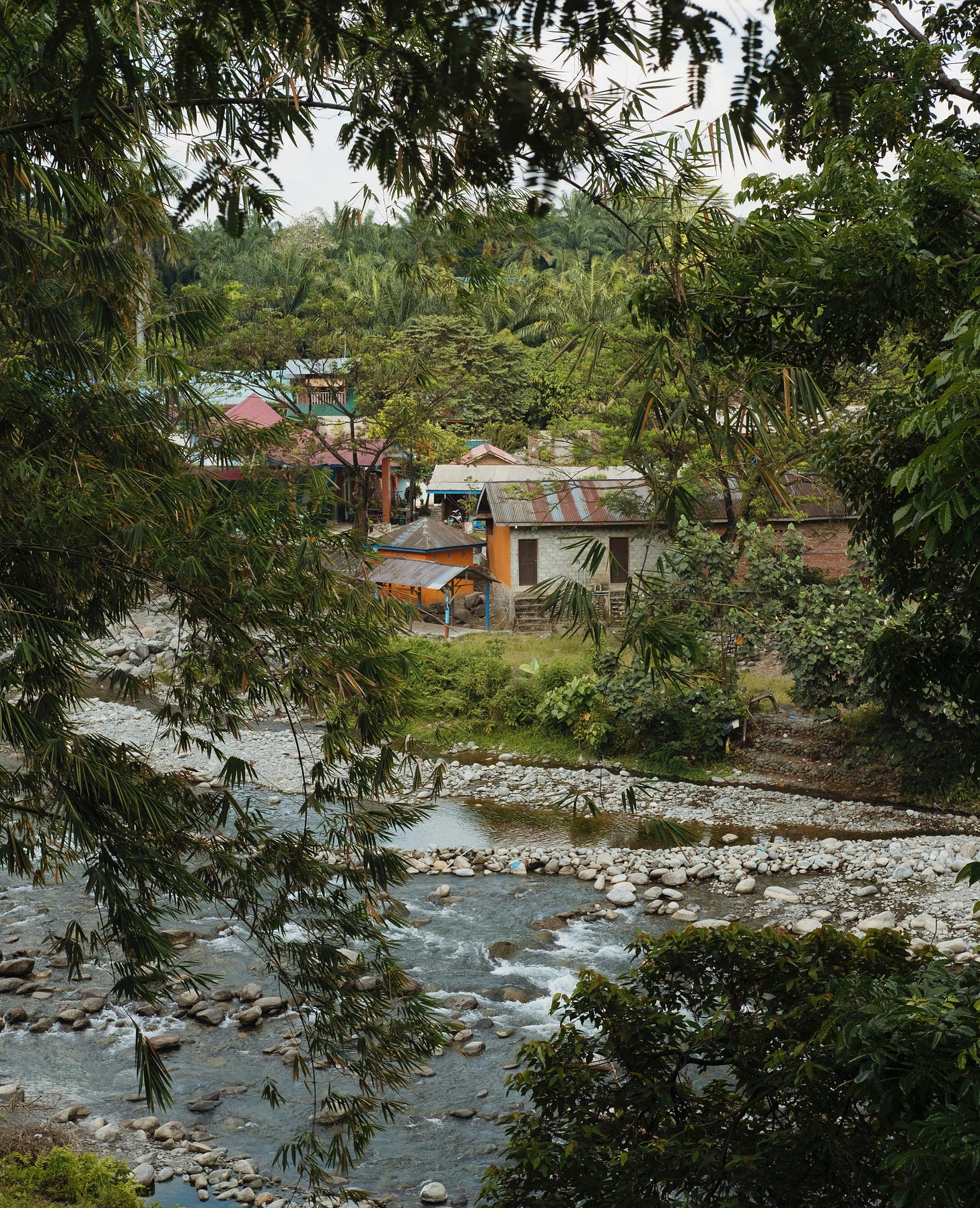Sleep in the Rainforests of Sumatra
Read in browser or the app to enjoy the full story. At the end of this letter you will find links to learn more about how to get to Bukit Lawang and go on a Jungle Trek . You can also see the whole visual story on my website.

Here’s a fun plan for the adventurers! You don’t have to be a National Geographic explorer to do this—I’m a certified city girl, and there I was, swimming in a river in the depths of one of the richest rainforests with a huge lizard floating downstream. (Okay, I jumped out immediately, but to be fair, the poor thing got just as scared and scurried away.) (He wasn’t that huge either.)
I’m a certified city girl, and there I was, swimming in a river in the depths of one of the richest rainforests with a huge lizard floating downstream.
In 2020, before the world went on lockdown and before our baby was born, we had the opportunity to visit a place recommended by some traveller friends. It’s not popular in tourism guides, but it is part of an eco-tourism initiative raising awareness about deforestation, biodiversity loss, and wildlife conservation. Tourism here also provides an alternative income for remote villages that would otherwise rely on exploitative palm oil plantations.
Crossing the Palm Oil Plantations in Sumatra
The jungle treks in Bukit Lawang let you experience nature in its raw and pure state. Guesthouses and lodges are scattered all around the village and you can book one of two options directly through your guesthouse: a day trek to see the orangutans or a full-day trek, a night camping in the rainforest, and a half-day trek back. Guess which one we chose? Yeah, once we’re in, we’re all in!
The adventure started with a three-hour car ride from Medan, Sumatra’s capital—the last stretch was an hour and a half through rubber and palm oil plantations. We kept seeing exhausted trucks full to the brim with palm fruits, its drivers, lacking safety gear. The palm trees had an almost greyish colour and were neatly and uniformly planted in endless rows, lost in the eerie horizon.

To keep things light, I’ve included links to learn more about these the impact of palm oil’s production on biodiversity and climate change at the end of this newsletter. It’s narrated by David Attenborough (way more fun than any narration I could make).
Jungle Trek In Bukit Lawang
Much like a safari, there is no guarantee that you will see any animals on this jungle trek—the chances increase the longer you stay in the rainforest. I have a phobia of snakes, and the thought of them made my heart flutter, but luckily for me, they never made a feature in this story. (Apparently it was ants that we had to keep an eye for). We did see plenty of wildlife, from monkeys to the last remaining orangutans from a conservation program that closed in 2002. Those orangutans still depend on humans for food; otherwise, please know that it’s not safe to see an orangutan that has never been in contact with humans, especially without a trained guide.

Once I began the trek, the loud metallic sounds of the cicadas, the sweat, and the thumping of my heartbeat made me embrace the habitat and leave all fears behind. We encountered the mama orangutan and had to keep our distance as she was a little unpredictable, and our guides were trained to scare her away if she came too close to us.
We encountered the mama orangutan and had to keep our distance as she was a little unpredictable and our guides were trained to scare her away if she came too close to us.
We learned about the tragic story of a ranger capturing her baby, which had left her weary of humans. Our poor guide had a big bite on his leg after encountering her on a past trek.

Thanks for reading Travellera! If you are enjoying this post, sharing it with your community helps me immensely in reaching more like-minded people. Your support means the world! ✨
The trek was physically challenging as we made our way through an invisible path that Wisnu, our guide, had learned by heart after almost one hundred treks. We climbed up and down under massive tree canopies, stopping to admire how the roots intertwined, creating massive abstract sculptures. We spotted orangutans having fun at the top of some trees—truly one of the most magical moments—as well as Thomas Leaf monkeys, tortoises, lizards, and a short-tailed macaque that tried to attack us. First, he pretended not to see us. He stood there, looking up—quite the sight—but the second we started walking again, he charged aggressively towards us. “Run! Run!” said the guide behind us. Our guide’s assistant stayed behind, making the right noises and moves to scare him away—and he did (gulp!).

When we finally reached the camp, we were wrecked, all of our muscles were in pain, and our clothes were drenched. There, we met Alan, our cook for the night, who made the most delicious rendang we’ve ever had. We camped by the river, the place where I had my encounter with the floating lizard. The campsite was a rickety open-air tent with blankets and a gym mattress. As the night fell, we had long conversations with the guides, played board games, and made orangutan faces with rocks.


Nothing prepared us for the sounds of the jungle at night—a loud symphony of animals calls, all played in unison. Then, as the night deepened, the sounds quietly faded.
Some people tell ghost stories while camping, but my fears were real: What about the Sumatran tiger? (Spoiler: It’s almost impossible to see one, but still—what if he decided to come around to see what’s up?) And the snakes?
“Don’t worry, we have spread salt around the camp so they won’t come near us.”
Salt? Okay, well… I was in the hands of our young guides—who, by the way, slept OUTSIDE the tent—and a protective magical circle of salt. What I thought would be nature’s version of a white noise machine ended up being the very human snores of the older guy trekking with us that didn’t let me sleep that night.
What I thought would be nature’s version of a white noise machine ended up being the very human snores of the older guy trekking with us that didn’t let me sleep that night.
The next day, we all woke up exhausted, but the trek had to continue, and to our delight, the last part of the trek was a raft down the river into the village.
We extended our stay for a couple of nights because we felt so sore, but it was worth it—the reward was a chance to observe the slow rhythm of life in the village. At night, we had dinner at a local spot our guide recommended, with live music in the background. The next day, slightly less stiff, we met some local kids who couldn’t get enough of the drone flying above us.

Review of our Jungle Trek in Bukit Lawang
I think that everyone should experience nature and culture in a place where tourism supports conservation and local communities at least once in their lifetime. Thinking back, nothing ever felt unsafe—the occasional monkey brawl near the lodge can be loud but nothing threatening.
Being there, it’s impossible not to reflect on how our lifestyle choices impact the environment and communities in less developed areas. I’ve become much more conscious of avoiding palm oil and choosing the sustainable options.
When the pandemic hit, fragile economies like this one suffered immensely. Our guide eventually reached out for help—there was no tourism therefore no income. A stark reminder of how interconnected we all are.

How we got there: We took a direct flight from Bangkok to Medan. From Medan’s airport, we took a train to the main station and walked to our accommodation at Kama Hotel. We enjoyed dinner and people-watching at Tip Top and arranged for a taxi via the Grab app to drive us to Bukit Lawang.
Where to Stay in Bukit Lawang: We stayed at two locations—Green Travelodge and Ecolodge. The latter was bigger and more comfortable for us. We've lost contact with the guides, but a tour can easily be arranged by the staff at the lodge or guesthouse. I recommend meeting them in advance to see if you connect; we met Wisnu and Dani, and they were both very friendly and knowledgeable.
What to pack: Pack lightly, bring plenty of water, and wear breathable clothing. The rainforest is humid, so sweating is guaranteed. I’d use most of the space in your bag to pack an extra outfit. I wore my hiking boots, but Kevin wore his running shoes and managed the trek just fine. For the overnight stay, I packed flip-flops, a long-sleeve shirt, and a pair of long leggings.
What to know: This community is Muslim; however, Islam in Indonesia is different from that in the Middle East (dare I say, more relaxed?). Locals are used to tourists wearing shorts and sleeveless shirts, but it’s still good to show respect for the community by dressing modestly and behaving appropriately in the village.
Further reading and watching:
All pictures from this story can be found on my website.
Watch Dave Attenborough in Our Planet explaining the situation in the Sumatran rainforests.
Learn more about Palm Oil Production and it’s effects on the environment.
If you enjoy my photography and writing, consider becoming a free or paid subscriber—it’s the best way to support my work and keep it going. Thank you✨







Damnn!! This is crazy, I’m all in for this!! 😍
Beautiful story! Sumatra was one of my favorite places in Indonesia.